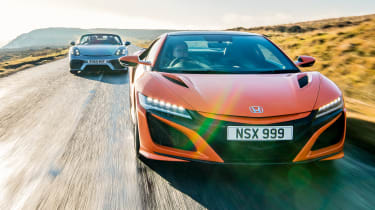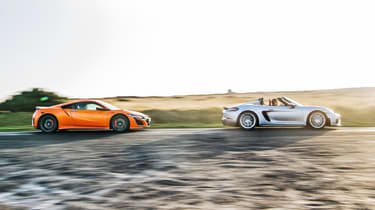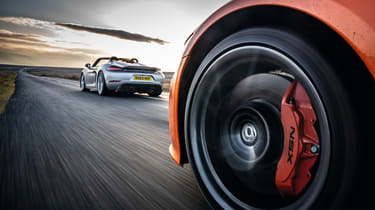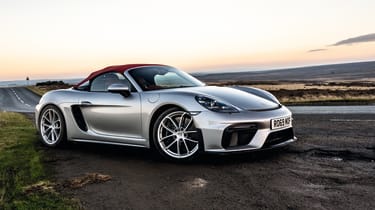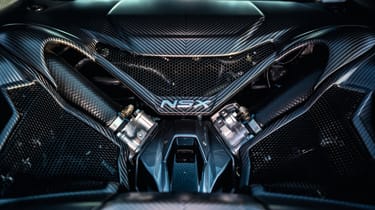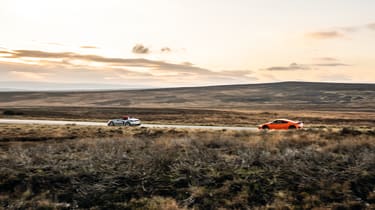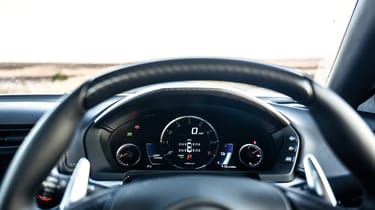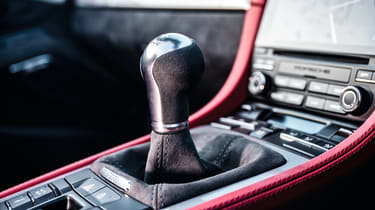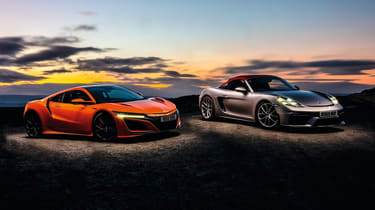Honda NSX v Porsche 718 Spyder – mid-engined six-cylinders go head-to-head
One is loaded with hybrid technology, the other is a purist’s dream, but the mid-mounted, six-cylinder powertrains of Honda’s NSX and Porsche’s 718 Spyder are both cause for celebration
Moorland folds out ahead, an uneven duvet of winter-ravaged vegetation glowing amber in the early morning sunlight. It’s broken only as it reaches the horizon, and by the irregular, paved evidence of humankind that follows its contours, dipping and cresting and occasionally twisting around some insurmountable natural obstacle.
Most of the time the moors lay silent, disturbed at this time of year only by the chatter of a landing grouse. Today though, another sound is breaking the air waves. It’s industrial and brash, stark in its contrast to the wind and wildlife. The source is somewhere behind my head, linked to my right foot through Matrix-like code, and sounds like the digitised bellow of a prehistoric creature.
> Honda NSX V10 – Dead on arrival
Ahead is another sliver of artifice among the unspoilt surroundings. It dances across the surface in a way that seems much more at home here, as if there’s more to it than human hands. I can just make out its own call above the one I’m conducting: strident and mellifluous, rising and falling in pitch as it navigates the topography, occasionally reaching a crescendo before it’s punctuated and the chorus starts again.
I wasn’t expecting a third sound, though. This one doesn’t fit the landscape. It’s piercing and shrill, and increasing to painful levels, drowning out everything else. Is it one of the cars? Maybe something’s broken? Things are going fuzzy now. The moorland glow, the pastel skies, and the howl of internal combustion are fading to black…
Consciousness crystallises and I’m yanked harshly from the Land of Nod by the sound of a fire alarm. I hit the lights, throw on whatever clothes are lying around my hotel room and head downstairs with my wallet, phone, and the keys to a Honda NSX and Porsche 718 Spyder. North Yorkshire in December can be a little brisk, but at least I’ll be able to sit in the car if we’re out here a while.
Check the phone: just before half six. In another couple of minutes I’d have been rudely awakened by my own alarm anyway, ready to head out onto the moors to catch the sunrise. A check of the building by the night staff suggests it’s been a false alarm, but there’ll be no returning to dreamland any time soon. Yet that’s of no concern – in half an hour or so we’ll be back out and doing it for real.
Bit of a curious duo, you might think, the Spyder and NSX. They have more differences than similarities: the latter amounting to six cylinders mounted between the cabin and the rear wheels. Otherwise, one’s a straightforward (albeit finely honed) open-topped sports car, the other among the world’s most advanced supercars and wearing a price tag twice the size. Natural aspiration, a manual gearbox and rear-wheel drive plays turbos, a double-clutch ’box, batteries, motors and all-wheel drive. David apples and Goliath (almost literally) oranges.
But their differences are what make them an intriguing pair on today’s performance car landscape. Automotive variety is a delicate subject at the moment – one in three new vehicles sold in the UK is an SUV, and taller vehicles seem to make up an even greater proportion of new model launches – but when you see just how much can be done with six cylinders and a mid-engined layout, perhaps there’s hope for us yet.
There’s another reason for bringing this pair together, because where Honda has been alone dangling its toes in the hybrid sports car pool since 2016 it is soon to be joined by plenty of others. McLaren has already confirmed its Track 25 programme will result in all its cars being powered by a hybrid powertrain by 2025. Aston Martin, too, will use a new V6 engine of its own design working with a form of hybrid technology for its forthcoming Vanquish and Valhalla mid-engined supercars. Then there is Audi, which will replace the current R8’s glorious V10 with a hybrid powertrain when the all-new model arrives post 2024.
And Porsche? After future-proofing the 992 to take a conventional hybrid powertrain (hence the car’s size), an insider has since told evo that the advancement in hybrid powertrains has resulted in a rethink on the direction any future hybrid-powered 911 should head.
But essentially the NSX is a real taste of what’s to come – and the Spyder a shining example of what we could be missing.
When you learn how much is crammed within the Honda’s wheelbase it’s a surprise there’s even room for a driver, or that you’re not surrounded by wires and time circuits like in Doc Brown’s DeLorean. You could probably fill a novel with the detailed run-down, but for brevity the latest NSX’s V6 is a 3.5-litre unit based very loosely on the J-series design that replaced the original NSX’s C-series V6. The 75-degree bend is wider than on other contemporary Honda V6s, however, while a pair of turbochargers and a 47bhp integrated electric motor (sitting between the engine and nine-speed dual-clutch transmission) give it somewhere north of 500bhp. The exact figure is hard to pin down: petrol power and electric motors rarely deliver their best at the same point.
The NSX’s all-wheel drive is achieved through a pair of electric motors at the front axle. Their 36bhp and 54lb ft outputs contribute proportionately little to the quoted 573bhp peak combined total, but they do allow you to drive on electric power alone for short bursts and can operate independently for a torque vectoring effect. The downside of all this tech is weight: at 1776kg, the Honda is over a quarter-ton heavier than the Porsche.
In bright orange in the wilds of Yorkshire it certainly overshadows the 718 Spyder alongside, which has the same subtlety as the dark blue Cayman GT4 on last month’s evo Car of the Year test. The Spyder, for the first time, shares much of what can be found under the GT4’s skin, too, and is no less appealing to those of us who derive satisfaction from the pure mechanics of driving.
Porsche’s 992 Carrera donates its flat-six to the Spyder (and the GT4), minus the turbochargers. Instead the 3-litre unit has been bored out to 4 litres (stroke remains the same), the extra capacity over the old Spyder’s 3.8-litre engine yielding 414bhp to its predecessor’s 370, while peak torque of 310lb ft is no greater but is developed a few hundred rpm higher. In an effort to reduce the 4-litre’s thirst it uses cylinder deactivation to cut fuel to three cylinders under light loads.
Otherwise, you know the score. The Boxster was Porsche’s reintroduction to mid-engined cars, and the engine has remained in the same place ever since. Capacity has grown and fallen – Boxsters arrived in the 1990s with 2.5 litres, while the latest flat-four is only two litres in non-S trim – but like its predecessors the Spyder eschews a PDK gearbox for a more traditional six-speed manual.
Weight is kept down with a manual roof (easier to erect and stow than its vestigial appearance suggests) but light weight is relative – at 1420kg the Spyder’s hardly an Elise. Tech is at least relatively minimal – the steering is electrically assisted (something Porsche has pretty much nailed these days) and the gearbox can auto-blip on downshifts, which should be handy up on the moors, although you can turn it off.
It’s not the Spyder I’m driving first, though. It’s bitterly cold and I’d rather get used to the conditions with the NSX’s all-wheel drive and from its more cosseting interior. However, on wet and salty roads this also means dealing with a design that seems aerodynamically shaped to deposit nature’s worst directly onto all the windows, so the usually fantastic visibility over the low scuttle is somewhat compromised.
There are some aspects of the NSX that make you wonder whether Honda was so engrossed in the powertrain it forgot to troubleshoot the rest of the car. The visibility in poor weather is one, exacerbated by headlights that also seem to scoop muck directly from the road, quickly limiting their output. This morning’s fog is making visibility even trickier. I pick my way cautiously through the moors, the Spyder’s slim LED tail lights ebbing in and out of sight in front as the clouds roll across. The NSX is making light work of the surface and the combination of all-wheel drive and a responsive dual-clutch transmission makes for a low pulse. We’re hardly going quickly, but the Porsche in front can’t feel as relaxed as this.
Gradually, the fog thins, the sky brightens, and Yorkshire glows under the low sun, not unlike in last night’s dream. The road is drier too, creating the perfect opportunity to experience more of what the Honda’s powertrain has to offer.
Easy speed certainly isn’t an issue. A consistent characteristic of hybrid and electric vehicles is the absence of lag to throttle inputs. In the NSX, this manifests itself as a kind of virtual throttle response, where any moments the combustion engine takes to wake up are compensated for by the electric motors. The actual feel is very different from the pick-up of a good naturally aspirated engine because there’s no gradual swell of acceleration – the car just switches from its steady state to an elevated rate of speed.
At the same time, the Honda’s not as instantaneous as some of the more powerful EVs currently on sale, nor certain plug-in hybrids such as the Polestar 1. When a much greater percentage of a car’s overall output is via its electric motors rather than a combustion engine, it’s much less compromised by the need to do combustion-engine things such as spooling up turbochargers or changing down gears. Suddenly ask for half-throttle in the NSX and it accelerates in two stages – an initial increase from the electric motors, and a second burst once the engine and gearbox come on-song. Ask for full throttle and you get a similar effect, but the separation is more difficult to discern simply because full throttle in an NSX means suddenly going very quickly indeed before your mind has properly processed the new information.
The Honda is startlingly potent when everything’s singing in harmony. If some cars are too quick to get the best from a manual gearshift, then the NSX goes one further: you barely have time to click the paddles at full throttle. Better to leave it to its own devices, trading one gear for the next around 7500rpm as the needle blurs over the final few thousand revs. Few gearboxes, even dual-clutches, are seamless when changing so quickly, but the NSX’s gets close, leaving little time for respite on the relentless lunge towards the horizon.
With so much torque to the rear tyres, flat-out acceleration isn’t as drama-free as some all-wheel-drive cars make it feel. Ask for too much with any steering lock on and the NSX will skitter and slip, and even in a straight line the power quickly overwhelms the rear tyres on damp roads. No doubt traction would be closer to absolute on a smooth, dry surface, but there’s enough drama here to dispel any notion that all-wheel-drive security and hybrid tech are some kind of excitement lobotomy.
There are no such concerns with the Porsche. If it’s true that you don’t know how good you’ve got it until it’s gone, then Porsche’s installation of a flat-four when it introduced the 718 Boxster and Cayman was something of a wake-up call. Objectively, the 718 was better than ever, the new engine offering more performance and making it even easier to access the 718’s beautiful balance at more sensible speeds. Subjectively… mid-’70s Beetle with a Cherry Bomb.
You could consider the Spyder, then, a welcome return to the good old days. But that makes it sound old-fashioned, when arguably it feels fresher than the turbocharged fours just because its behaviour is so clear, bright and defined, like a glass of Riesling after a month spent drinking Kellerbiers at Oktoberfest.
It has similar clarity after driving the NSX, and makes you wonder whether anything can deliver the same purity of experience as a well-tuned naturally aspirated engine and three pedals. From the nanosecond you tickle the throttle and introduce clutch disc to flywheel, the Spyder is utterly intuitive to drive, and makes you value not just Porsche’s persistence with its flat-six but also its dogged determination to offer drivers the option of a manual transmission.
At idle the Spyder’s engine has an industrial tone, with a slight hollow resonance roof-down that the tin-topped Cayman GT4 blocks out. The feel underfoot is textbook Porsche – just enough weight to the floor-hinged throttle to offer some resistance, but the gentlest of touches lifts the tacho needle off its stop. The pedal’s arc is so measured that if a trackday noise tester asked you to hold the engine at 4500rpm you could have the needle hovering within a millimetre either side of it within an instant, and this level of control seems to make it equally easy to pull away from little more than idle as to do a full Grand Prix start.
It’s the same on the move, where gaining or losing speed is directly proportional to the movements of your right foot. Yawning ratios stifle the Spyder’s ability to really leap forward at small throttle openings, at least in higher gears, so there are times when the instantaneous hit of the Honda’s electric motors makes it feel more eager despite its weight and complexity. But often the more organic, more consistent feel of the Porsche makes it feel more alive to your inputs.
The manual gearbox plays its part. You can choose your own gears in the Honda too of course, but it feels almost second nature to block-change the Spyder’s six-speed from fourth to second for a tight corner, where a similar change in the NSX requires two or more passionless clicks of a paddle. Porsche’s automatic rev-matching system is faultless, but when you’re craving interaction there’s no better way of engaging with the drivetrain than timing left arm and both feet in a proper heel-and-toe downchange.
Most glorious of all, you get to listen to that engine as you do any of this. Any drive with this flat-six feels like a dip into decades of history, the metallic timbre down low and rich howl up high evoking racing RSRs and GT3s. It’s an evocative sound but also an exotic one, something the 718 flat-four couldn’t replicate. Even the Honda struggles; its engine is less cultured somehow, a component that is part of the powertrain, rather than being the powertrain component. The Porsche’s one sonic quirk is its fuel-saving cylinder deactivation, which introduces an intermittent low-pitched resonance. Not a deal-breaker.
The Honda is the quicker of the pair, though it’s fair to say the Spyder is hardly slow. It could feel more enthusiastic still – that long gearing is once again at fault – but every flat-out run in the Porsche is a treat. You have a little more time to think than in the blisteringly fast Honda, and perhaps enjoy the process of acceleration more as a result. It hooks up cleanly from rest, and has enough thump in the lower gears to make corner exits as fun as clipping apexes.
Handling isn’t the focus of this story, but each car’s behaviour under lateral load is analogous to its drivetrain. The Honda feels immensely capable and slightly aloof, the Porsche dialled in and as familiar as the family pet. The NSX’s clever drivetrain can shuffle the power around to wherever it’s required, neutralising understeer (not that there’s much of that in the first place), while the Spyder simply follows your inputs, its steering yet another control perfectly matched with everything else.
Each car’s mid-engined layout gives it a delicate, inertia-free feeling on turn-in and results in each axle sharing the load in steady-state cornering, but while the Honda’s adjustability can really only be unlocked on a circuit, the Porsche feels malleable at regular road speeds. The NSX is point-and-shoot, on the road at least, while braking, lifting and accelerating are all additional ways of cornering in the Spyder. For greater ability the answer is NSX, for greater agency over the car’s behaviour, it’s the Spyder.
No one approach is better than the other, even if the Porsche is the kind of car we hold closer to our hearts at evo, a car to get under your skin rather than respect from a distance. That much is obvious, given its stablemate’s victory in eCoty last month. That said, spending more time with the NSX is an enlightening experience, as much for what it does when the V6 is slumbering as when it’s roused. Six cylinders may be the driving force behind this story, but the Honda’s ability to cruise engine-off, particularly around town where even relatively simple cars such as the Spyder are beginning to feel slightly antisocial, plays a big part in its appeal – and will soon be a requirement if performance cars are to be allowed inside city limits. That said, an indicated 27mpg after a week suggests the Honda’s hybrid tech is geared more towards performance than frugality.
Driving a sports car or supercar is an enjoyable but increasingly fraught experience in a world that more and more views cars with suspicion and contempt. The endgame for petrolheads will surely be a car combining the engrossing tactility of the Porsche with the technology and occasional silent, clean running of the Honda. If a mid-mounted six-cylinder is somewhere in the mix, all the better.
Specs
| Porsche 718 Spyder | Honda NSX | |
| Engine | Flat-six, 3995cc | V6, 3493cc, twin-turbo, plus 3 electric motors |
| Power | 414bhp @ 7600rpm | 573bhp (combined) |
| Torque | 310lb ft @ 5000-6800rpm | 476lb ft @ 2000rpm (combined) |
| Weight | 1420kg | 1776kg |
| Power-to-weight | 296bhp/ton | 328bhp/ton |
| 0-62mph | 4.4sec | 2.9sec |
| Top speed | 187mph | 191mph |
| Basic price | £73,405 | £144,765 |
This story was first featured in evo issue 270.

